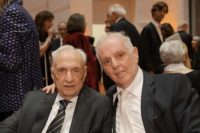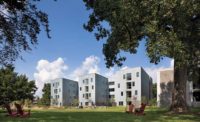Berlin is home to what is arguably the most influential concert hall of the 20th century, designed by Hans Scharoun for the city’s philharmonic orchestra and inaugurated in 1963. Smaller in scale than that 2,440-seat auditorium, Berlin’s newest music venue, Pierre Boulez Hall (a tribute to the late French composer and conductor) may be nearly as impressive in form and context.
Additional Information:Jump to credits & specifications
Designed by Frank Gehry, the 683-seat hall is part of the Barenboim-Said Academy (BSA), a new conservatory founded by maestro Daniel Barenboim to foster communication through music. The school, which trains young musicians from the Middle East, North Africa, and around the world, was named for Barenboim and his colleague Edward Said, the late American-Palestinian scholar, with whom he established the West-Eastern Divan Orchestra in 1999 to enable young Palestinian and Israeli musicians to play together.
In 2012, when Barenboim invited Gehry to design the venue in the building that houses the school, the architect accepted—and waived his fee. A friend of Barenboim and Said, as well as Boulez, he too wanted to help people overcome their differences and connect, sensing that a performance space was the perfect staging place to help accomplish this. “People talk more easily to one another through the arts,” says Gehry, noting how he has observed this at meetings in the Gulf region with people from diverse backgrounds when the subject turns to culture.
The BSA, which opened in the fall of 2016, occupies the former scenery warehouse of the Staatsoper (State Opera House) Unter den Linden, a landmarked Neobaroque monument rebuilt in the early 1950s after being destroyed during World War II. The building, refurbished by the German firm HG Merz, fronts a side street in the Mitte district, now a hub of government, educational, and cultural institutions. The entry leads to a small central atrium, raised 3 feet above street level. From there, visitors can access both the school and Pierre Boulez Hall.
Located within the building’s east wing, the concert hall features a flexible stage for performances by soloists and ensembles, and rehearsal space for the 90-member West-Eastern Divan Orchestra. According to Gehry, during the design phase, he initially “kept drawing an oval” within the regular plan, a square box with walls measuring about 80 feet in length. While he eventually rejected this idea for a more conventional layout, with sloped seating on risers facing performers on a stage, Barenboim urged him to return to the oval.
The resulting structure contains two distinct elliptical elements. The axis of the lower level roughly aligns along the hall’s northeast–southwest diagonal. Five rows of concentric seating step down 9 feet from the hall’s entry level to an arena-like floor. The bottom four rows can retract to accommodate a full orchestra; freestanding chairs and a compact conventional platform can also be added when smaller groups perform. The axis of the upper level shifts slightly and is almost parallel to the east and west facades. Designed as a “floating” balcony, the elliptical ring has an undulating section and is largely independent of the walls. Audience members, either seated on the two rows in the balcony or throughout the lower level, are at a maximum of 46 feet from the center of the stage.
The concert hall is akin to a “building in a building,” says Gehry partner Craig Webb, project designer. The existing interior walls and slabs were gutted, new foundations were laid, and a steel-and-reinforced concrete structure was inserted on the periphery. Four beams, one on each side, tie the floating balcony, constructed as a hollow, reinforced-concrete truss with a trapezoidal section, to the new structure. Douglas fir panels cover the ceiling, walls, and balcony.
Other decisions marry design elements with the need to optimize sound quality. Los Angeles–based acoustician Yasuhisa Toyota, who worked with Gehry on the Walt Disney Concert Hall, suggested an interior height of 46 feet to create enough volume for a full orchestra. Unlike a balcony in a typical concert hall, the one here is detached from the walls, so bowed glass sheets were hung beneath the eastern and western edges to return sound to the musicians. Because the architects insisted on keeping the windows transparent to insure seamless views to the city, three layers of glass in the deep window casings provide sound isolation. The creamy Alaskan yellow-cedar stage floor was selected because it is extremely resonant and enhances the sound of instruments that touch it, like cellos or pianos. When the light from the adjustable-LED Tungsten fixtures bathes the surface, “the whole room glows from this central focus” says Webb.
For all its technical finesse and adventurous form, Pierre Boulez Hall is an unexpectedly emotional and atmospheric place. The balcony hovering above the columnless volume directs one’s gaze toward the windows, out to the city. There is a sense of freedom and of endless possibilities, even hope. Moving closer to the center, the design recalls a clearing in the forest, the stage being a luminous pond with the floating balcony as a ring of treetops, imparting an aura of security and enclosure.
“It is a special place,” says Ole Baekhoej, the hall’s artistic director. “It has a community feeling, with everyone seated together around the musicians. It is not a ‘them versus us’ layout, but all of us together.”
CreditsArchitect: Gehry Partners (Pierre Boulez Hall) —
Executive Architect: RW+ Architekten
Engineers: GSE Ingenieur-Gesellschaft (structural)
Consultants: Nagata Acoustics America (acoustics);
Client: Barenboim-Said Academy
Size: 10,660 square feet
Completion date: March 2017
|
SpecificationsGlass Guardian Glass (curved acoustical fins) Seating Seda Sport (fixed audience seats designed by Wilde Spieth (freestanding chairs) Textiles Serge Ferrari (acoustical); Maharam, Kvadrat (custom fabric for audience seats designed by |

























Post a comment to this article
Report Abusive Comment